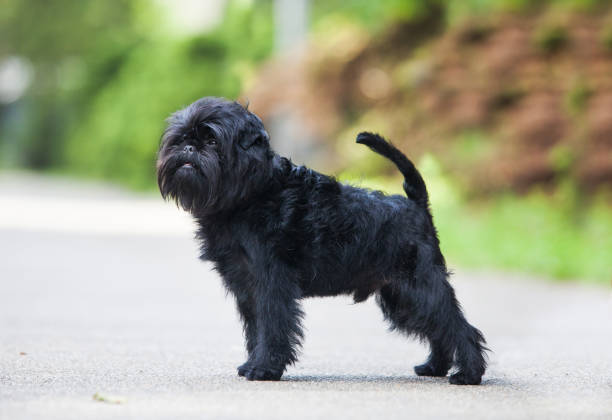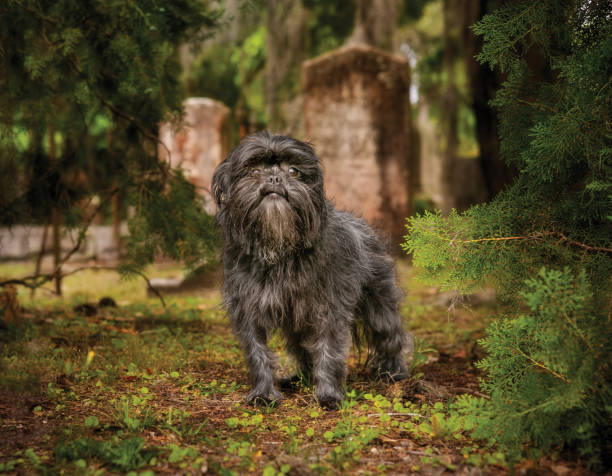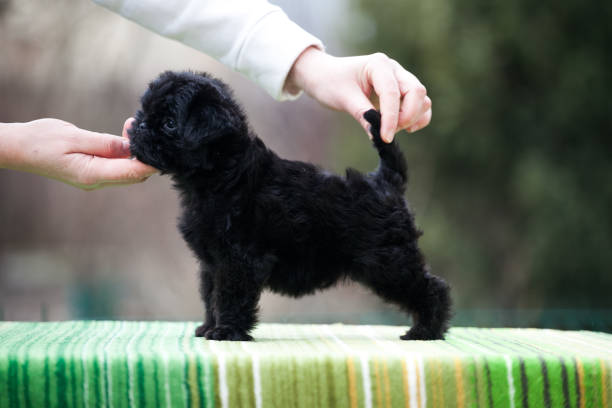Affenpinscher

Breed History:
The Affenpinscher, whose name means “monkey-like terrier” in German, originated in Germany during the 17th century. It was initially bred as a small ratter, used to control vermin in kitchens, barns, and stables. Over time, breeders refined the breed’s size and temperament, turning it into a cherished companion dog for urban households and ladies of the court.
By the late 1800s, the Affenpinscher had been standardised in appearance and gained recognition as part of Germany’s early toy breed registry. It is considered one of the ancestors of the Brussel Griffon and Miniature Schnauzer. Though still relatively rare worldwide, the breed is adored for its spunky personality and unique, expressive face.
|
Gender |
Height |
Weight |
|
Male |
23-30 cm |
3-6 kg |
|
Female |
23-30 cm |
3-6 kg |
Size – Toy
Life Expectancy: 12–15 years

Breed Appearance:
The Affenpinscher is a small, sturdy toy dog with a square body, arched neck, and deep chest. Its most defining feature is its shaggy face, with bushy eyebrows, a beard, and a short muzzle that together give it a distinct monkey-like expression.
It has a rough, wiry coat, typically black, though other colours like grey, silver, or black and tan also exist. The tail is usually carried high and curved. The Affenpinscher’s dark, round eyes and prominent underbite add to its animated, quirky charm.
Breed Type – Companion:
Bred primarily as a companion dog, the Affenpinscher is lively, comical, and affectionate. It’s bold and curious, often acting much larger than its actual size. Despite its toy status, it retains a touch of the terrier’s fearlessness and independence.
It bonds closely with its owner and is known for its protective instincts. The breed is often described as entertaining, clownish, and expressive, making it a favourite among those seeking a small dog with a big personality.

Training:
Affenpinschers are intelligent but independent, meaning they can be both clever and stubborn. They respond well to positive reinforcement, especially with treats and praise, but may become bored with repetitive training.
Short, engaging sessions and early socialisation are key to preventing unwanted behaviours like excessive barking or possessiveness. They can excel in basic obedience and agility, though their playful, mischievous streak often shines through.
Health & Care:
Generally, a healthy and robust breed, the Affenpinscher may still be prone to:
-
Patellar luxation
-
Hip dysplasia
-
Eye conditions (such as cataracts or retinal issues)
-
Collapsed trachea
-
Dental problems
Routine veterinary care, proper dental hygiene, and a balanced diet help ensure longevity and well-being.

Living Conditions:
Well-suited to apartment living, the Affenpinscher adapts easily to small spaces as long as it gets enough attention and stimulation. It does best in quiet households and often bonds with a single person, though it can do well with families, too.
Because of its small size and sensitive nature, it’s best around older children who understand how to treat dogs gently. It doesn’t tolerate long periods of alone time and prefers to stay close to its humans.
Exercise:
Though energetic indoors, the Affenpinscher’s exercise needs are modest. A few short walks, some indoor play, and occasional games or puzzles are usually sufficient.
It enjoys being active and alert, but doesn’t require intense workouts. A fenced yard is a bonus but not a necessity. Supervised off-leash time in a secure area is ideal for this curious little adventurer.
Grooming:
The breed’s rough coat requires weekly brushing to prevent matting and maintain its texture. Hand-stripping (plucking dead hairs) is preferred to maintain the wiry quality of the coat, especially for show dogs.
Facial hair may need trimming to keep the eyes clear, and regular grooming tasks like ear cleaning, nail trimming, and dental care are essential. The Affenpinscher is a low-shedding and relatively clean breed.

Advantages:
-
Charming and entertaining personality
-
Compact size, ideal for apartments
-
Alert and protective despite small stature
-
Low shedding, relatively clean coat
-
Long lifespan and generally healthy
-
Good with other pets if socialised early
Disadvantages:
-
Can be stubborn and hard to train
-
Not ideal for homes with young children
-
Prone to barking if not properly managed
-
Requires regular grooming and coat maintenance
-
May develop separation anxiety if left alone too long
-
Independent nature may resist obedience training

